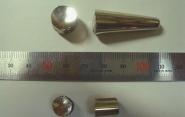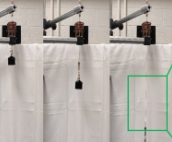By Adding Strain, Researchers Improve Metallic Glass

Metallic glasses – materials with the strength of metal, but moldable like plastic – are being developed for a broad range of applications. Controlling the formation of metallic glasses and their resulting properties in bulk form, however, remains a work-in-progress in the field.
Researchers in the lab of Jan Schroers, professor of mechanical engineering & materials science, have figured out a way to use strain to prevent molten metal from returning to its original state, resulting in a very strong and ductile metallic glass. The study, led by Rodrigo Miguel Ojeda Mota and Ethen Lund, graduate students in Schroers’ lab, was recently published in Communications Materials.
In a common method for creating metallic glasses, an alloy is melted and then cooled extremely quickly before its atoms have a chance to rearrange themselves into their original crystalline state. This disarray of atoms is what gives metallic glasses the combination of strength and ductility. However, it’s a process that works only with very small samples, in which sufficiently high cooling rates can be achieved.
“So the limitation is that you can never make anything really useful out of it, like a cellphone casing or a gear or a propellant tank for satellite,” Schroers said.

The researchers tried a different approach, using strain to prevent the material from relaxing back to its original atomic structure. After heating the alloy - in this case, the alloy Zr44Ti11Ni10Cu10Be25 - to a temperature that causes it to transition to glass, they allow a small weight to pull the material down during the cooling stage (left). It’s essentially a battle between the material’s tendency to relax to a crystalline atomic structure and the mechanical strain that keeps the atoms in disarray. Upon cooling, the material freezes as a metallic glass. The entire process takes a few seconds.
“By pulling this material at a high temperature, we’re dilating the atoms inside the metal,” Lund said. “As it cools, we’re freezing it in that dilation, and that’s the excited liquid state.”
Schroers said the process gives them the ability to greatly improve the mechanical properties of metals, and use them to create complex shapes.
Ojeda said the next step is to try the idea to different processes. “We are not interested in wires but will work on incorporating strain ductilization into blowmolding,” he said. “This would allow us to fabricate most shapes that metals are used for in a very high strength and ductile material.”

